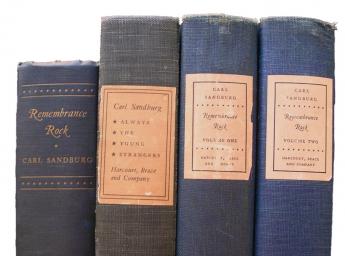Antiquarian Booksellers' Association of America Lighthouse Books, ABAA
Collecting Rare Books and First Editions - Carl Sandburg, Working Class Reporter

By Michael Slicker
At an age when many men settle down to daily golf games or fishing trips in the golden haze of retirement, Carl Sandburg kept right on working. He started his novel, Remembrance Rock, a sweeping saga of the American experience from the landing at Plymouth Rock to the beginning of World War II, when he was sixty-five years old.
Sandburg was already remarkably accomplished; he had received Pulitzer Prizes both for his book of poetry, Cornhuskers, and for his biography, Abraham Lincoln: The Prairie Years. Remembrance Rock was published when he was seventy. (A third Pulitzer, for another poetry book, Compete Poems, would come three years later.) He had worked all his life and he wasn't about to stop.
A signed and numbered first edition of Sandburg’s Remembrance Rock is in the collection of rare and unusual books at Lighthouse Books, ABAA, along with a signed first edition of Sandburg’s autobiography, Always the Young Strangers. The autobiography was published when Sandburg was seventy-five.
Sandburg worked hard all his life. He was the son of Swedish immigrants, who instilled in him an Old World work ethic. His father worked as a blacksmith’s assistant on the railroad. After graduating from the eighth grade, Sandburg quit school to help support the family. He held an array of jobs in his early years, driving a milk wagon, harvesting ice, threshing wheat and shining shoes in the Union Hotel in his hometown, Galesburg, Illinois. With his working class sensibilities, it is small wonder he became involved in Socialist politics in college.
Eventually he came to be a reporter for the Chicago Daily News, where he covered labor union news and wrote editorials and features. Playwright Robert Sherwood, a colleague and drinking buddy, said later, “Carl Sandburg is one of our great natural resources and I am proud to have walked with him, no matter how many years it may have taken off my life.”
Publisher Alfred Harcourt, founder of Harcourt, Brace and Company, knew Sandburg as a friend for forty years. He encouraged Sandburg to write the Lincoln biography. The project, however, was to have been a 400-page “Boy’s life of Lincoln” for teens, not the four volumes it eventually became. After it was published, Sandburg noted that, “It is probably the only book ever written by a man whose father couldn't write his name, about a man whose mother couldn't write hers.”
Richard Finnegan, who was editor and publisher of the Chicago Times and later a top executive of the Chicago Sun-Times, described Sandburg as a reporter first and foremost, and a man who understood the working class because he was part of it.
In a tribute Finnegan wrote regarding Sandburg, he shares a story of Sandburg in the early to mid-1930s, during the Great Depression. Sandburg had joined lunching group of doctors, lawyers, merchants and bankers, artists and writers, and even a priest and a rabbi. The conversation came around to the millions of people out of work. Somebody suggested that most of them didn’t want to work - they were the new leisure class, someone said.
“Suddenly Carl Sandburg let out a series of those great braying hee-haws of his,” Finnegan wrote, “ Ten million bums!’ he roared. ‘Yes, they're just ten million good for nothing lazy bums.’ Then, Sandburg began giving case histories: of a fellow he met in Duluth; of the guy coming out of Roswell, New Mexico, on a day coach; the Connecticut Yankee family, husband and wife and two teen-age daughters - all of the women posing as men” to obtain jobs.
“Carl had been bumping into the people - on the breadlines, on the roads, on the town. And now, as a reporter, he was reporting. Yes, Carl's a poet and a historian. Yes, he's a philosopher. Yes, he plays at the guitar and tries his best at singing - those old ballads and cowboy songs. But first he's a reporter. A reporter, yes. His Lincoln is reporting. He was right at Lincoln's heels, up and down and across the prairies. His War Years is reporting. And so is Remembrance Rock.”
And so, too, is his autobiography, Always the Young Strangers, which covers those first tough 20 years with the mastery and vivid imagery, of those other works. A reporter, yes. And a man of the working class.
(Posted on the Lighthouse Books Blog, presented here by permission of the author.)
Are you collecting rare and fine editions of Carl Sandburg’s works?

